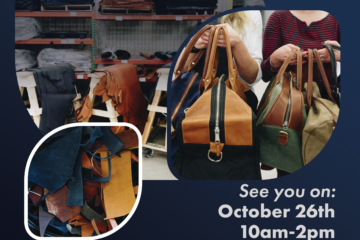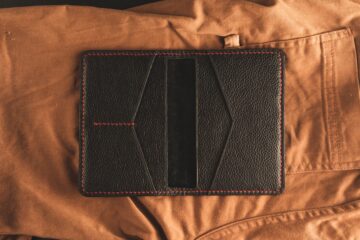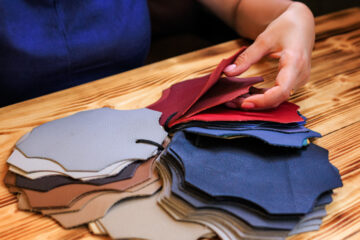Unveiling the Art and Science of Leather Tanning Processes
Leather is one of the oldest, most versatile materials crafted by humans. From leather bags to leather chairs, this material is prized for its style, durability, and versatility. The journey from raw animal hides to the supple, luxurious leather products we value is a complex and intricate process known as leather tanning. In this article, we will discuss the basics of leather tanning, including a brief overview of the purpose of tanning. Then, we will describe the two most common types of leather tanning: vegetable tanning and chrome tanning. If you want to know the difference between vegetable-tanned and chrome-tanned leather, keep reading!
The Basics of Leather Tanning
Since 7000 BC, leather has been used in clothing, furniture, armor, and more. This material is derived from animal hides and skins and undergoes a series of preservation processes, known as tanning, to turn raw hides into the durable, flexible, and attractive material we know. Before the tanning process can begin, one must source the right materials—animal hides and skins. Leather can be made from various animals, most commonly cattle, sheep, and goats. About 65% of leather comes from cattle, making it the most common animal hide for leather processing. Though cattle is the most common, each animal skin has unique characteristics that suit different applications and aesthetics.
Leather tanning is a preservation process. Since animal hides are organic materials, they would quickly decompose without this process. The tanning process chemically alters the cellular structure of the hide to prevent decay while maintaining the material’s beauty and durability. During this process, tanners use substances known as tannins to bind with the collagen fibers in the hide. This stabilizes the hide and prevents breakdown, creating a durable, flexible, and resilient material.
Traditional Tanning Processes
Let’s look at a few traditional tanning processes.
Vegetable Tanning
Vegetable tanning is one of the oldest methods of tanning leather. This method uses plant matter, like bark, to treat animal hides. These materials contain natural tannins that react to the collagen in the animal hides. Because this process uses vegetable matter, it is a sustainable and environmentally friendly tanning process. Vegetable tanning is a slow tanning process, often taking several weeks to complete. Vegetable-tanned leather has a natural appearance and patinas over time, making it a popular choice for saddles, belts, wallets, and artisanal leather goods. However, this leather tends to be stiffer and less water-resistant than chrome-tanned leather. Overall, vegetable tanning is a historically significant method that produces natural-looking, durable leather.
Oil Tanning
Another traditional method of tanning is called oil tanning. Historically, this technique relied on animal fats, like animal brains and fish oil, to soften and preserve hides. While this process is not typically used in modern leather production, it is a fascinating method that reveals the ingenuity of the earliest leather tanners.
The Modern Tanning Process: Chrome Tanning
Chrome tanning, also known as mineral tanning, is one of the most popular modern tanning methods. This technique uses chromium salts to tan animal hides rather than using vegetable matter. This technique is very efficient, only taking a day or so to complete. The result is a soft, pliable, and element-resistant leather favored in industries where durability and flexibility are essential. The efficiency of chrome tanning makes it a popular choice for many tanners, but there are some concerns about the environmental impact of chromium salts. Accumulation of chromium salts in the earth, particularly in water sources, threatens animal and human health.
This kind of leather can be used in a wide range of consumer goods, including shoes, handbags, furniture, and automotive upholstery. Chrome-tanned leather can be adapted to a wide variety of finishes and colors, making it a versatile choice for designers.
Which is Better: Traditional Tan or Chrome Tan?
Both tanning processes create beautiful leather pieces, but you may wonder: is one better than the other? In simple terms, no. Each type of leather is good for different kinds of goods and aesthetics. For example, if you are designing a leather belt intended for hikers or other outdoor enthusiasts, chrome-tanned leather will be a better choice because of its weather resistance and durability. Alternatively, if you are designing an evening handbag, veg-tanned leather may be a better choice, depending on the aesthetic. Ultimately, both types of leather can be used to create beautiful leather goods that will last for years to come.
How Can We Help?
Choosing the right leather for your branded soft goods can be challenging. Luckily, Softline Brand Partners is here to help. As a leader in soft goods manufacturing, they offer flexibility and scalability that benefit companies of all sizes. Softline Brand Partners is well-equipped to meet your designing, sourcing, and manufacturing needs with its domestic and overseas factories. Softline Brand Partners is a leader in soft goods manufacturing, offering flexibility and scalability that benefits companies of all sizes. If you’re a business looking to source high-quality soft goods sustainably, reach out to Softline Brand Partners today.











